The ancient architecture of Nepal can be broadly classified into three different styles-
1. The Pagoda Style
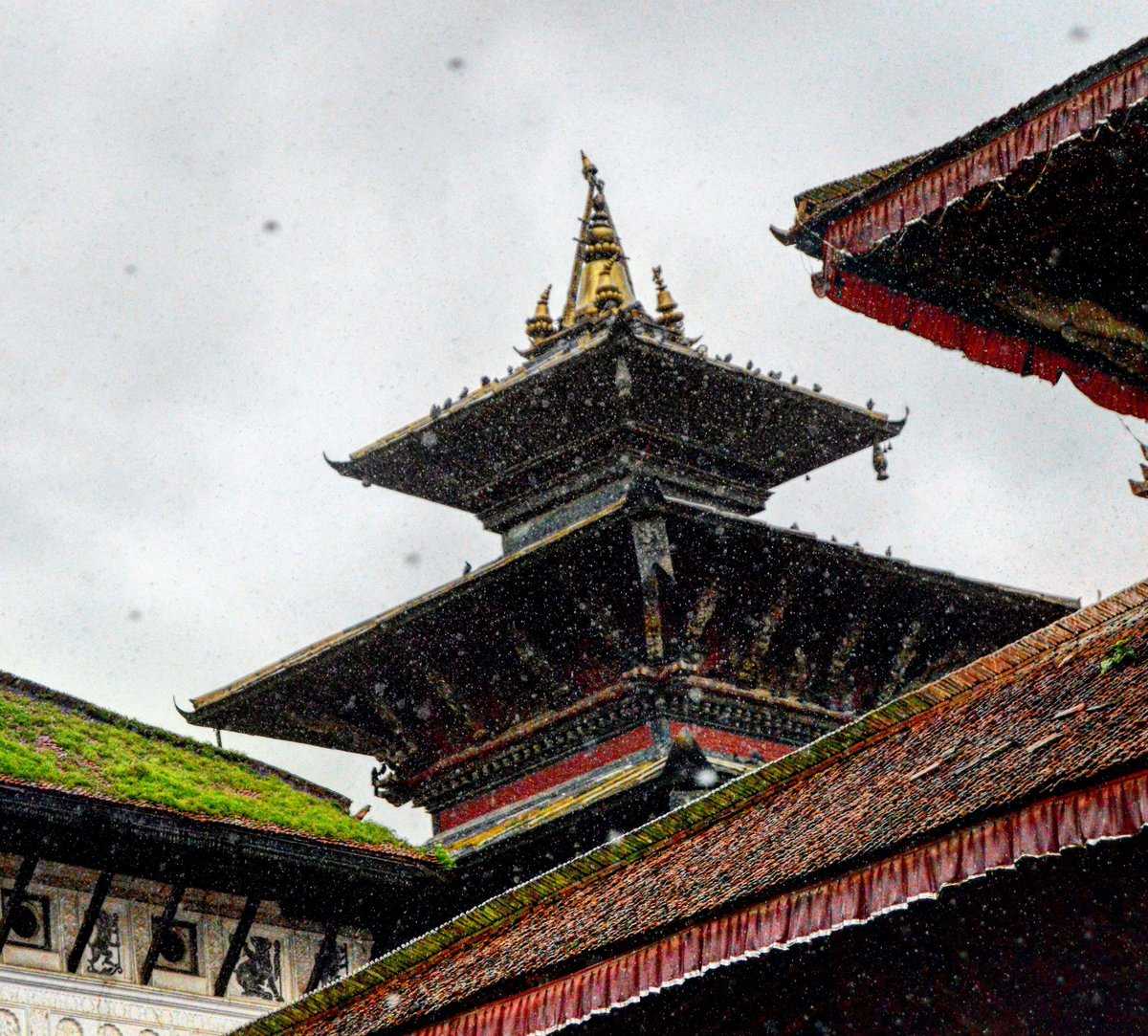
The pagoda style of architecture features prominently in the structures of ancient Nepalese shrines and temples, with multiple tiers of roofs arranged in ascending order from top to bottom, supported by intricately carved wooden struts. The protruding windows are characterised by latticed architecture, which has a criss-cross pattern. Originally made of gold and alloys such as brass and bronze, this style is believed to have originated somewhere around the beginning of the 13th century.
2. The Stupa Style
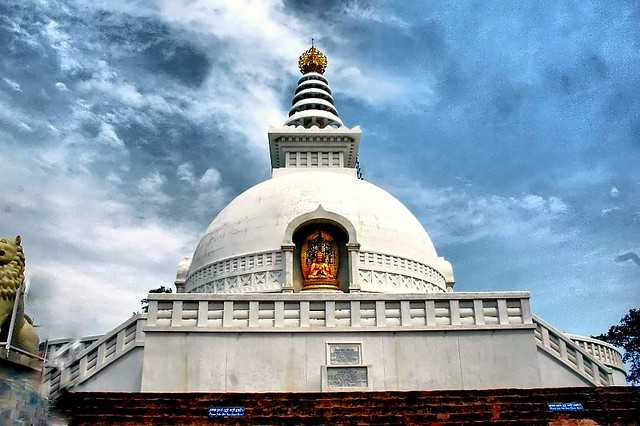
3. The Shikhara Style
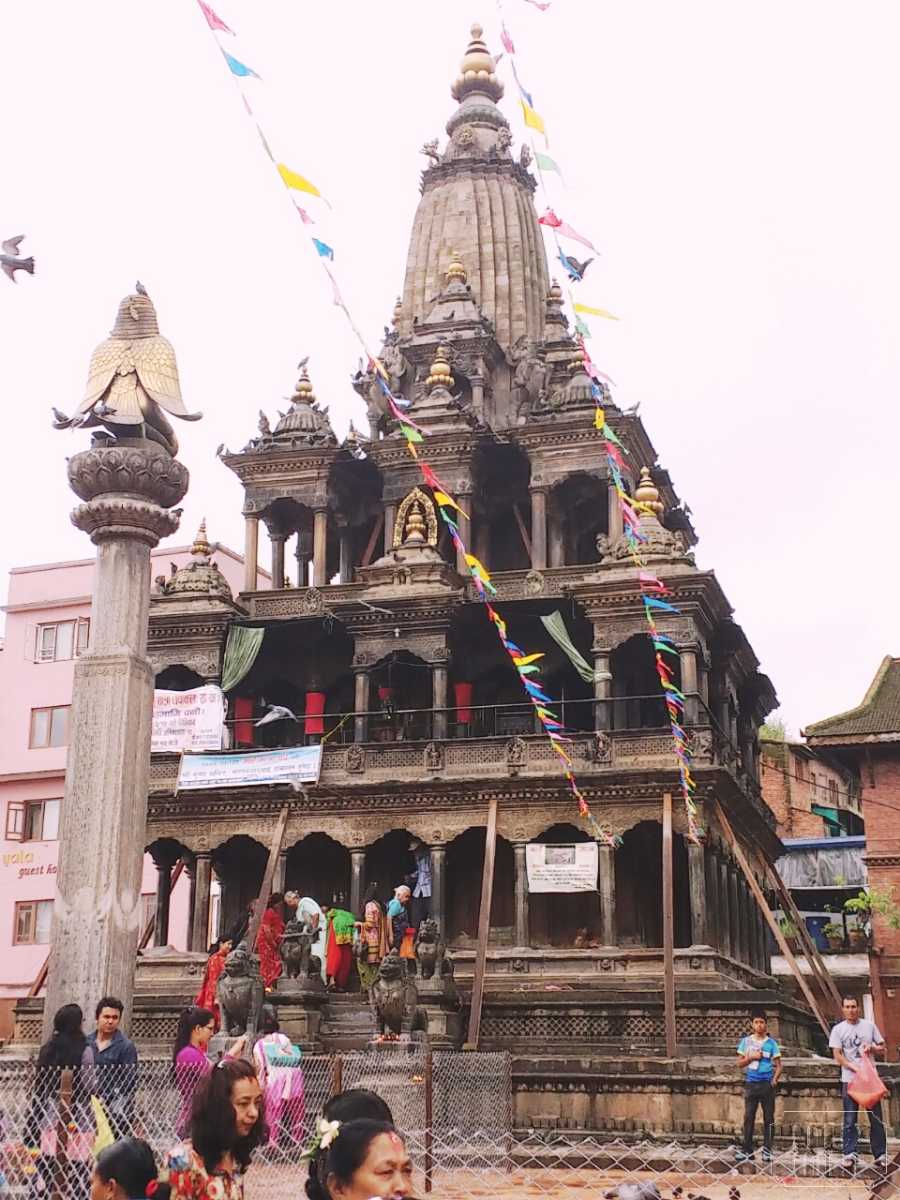
Marvels of Architecture of Nepal Based on the Above Styles are:
1. Pashupatinath Temple
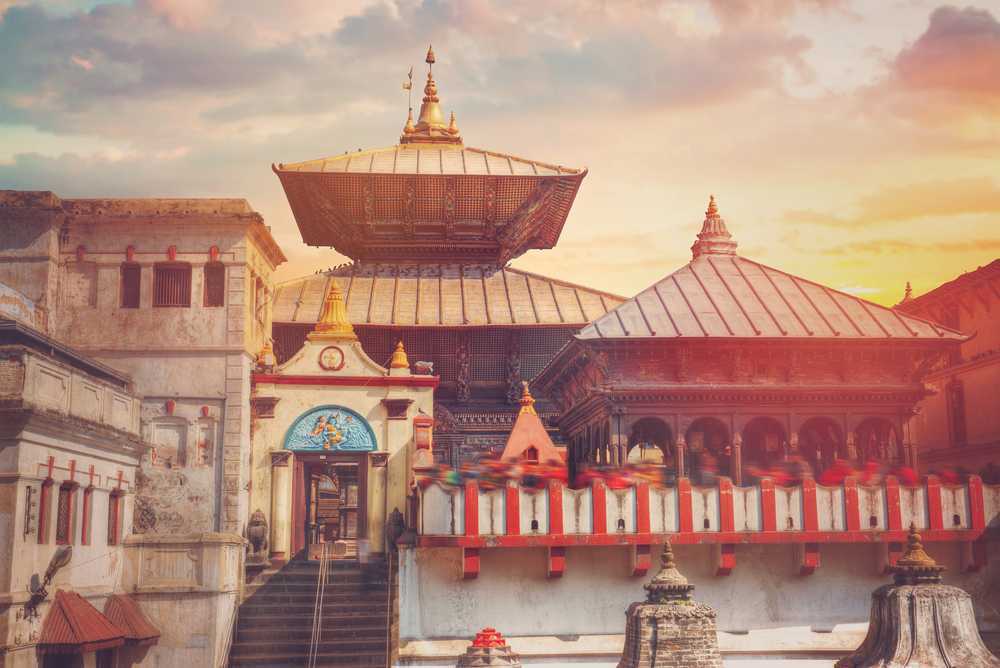
Considered to be one of Kathmandu’s oldest Hindu temples, this religious site dates back to the 5th century, but was later renovated in the 13th century by, Ananta Malla, a ruler of the Malla regime. After undergoing further damage, it was rebuilt again in the 17th century with exquisite artwork and as many as 492 temples along the main temple.
Architecture
One of the holiest shrines for devotees of Lord Shiva, this temple has a dual roof which is entirely made up of gold and copper, with intricately carved wooden rafters, which act as a support.
Highlights
The temple has four main ‘dwars’ or doors, made up of silver sheets and a golden pinnacle or ‘gajur’ at the top. The entire complex is separated into two parts. The inner complex hosts the idol for worship, whereas the outer complex is an open courtyard. The superior quality of this temple makes it one of the most excellent examples of the pagoda style of architecture of Nepal.
UNESCO Recognised
Situated on the banks of river Bagmati, the Pashupati temple complex is also one of the seven UNESCO World Heritage Sites in Kathmandu Valley.
Style of Architecture: Pagoda Style
Entry fee
Nepalese and Indian Citizens: No entry fee
Foreign Nationals: NPR 1000
SAARC National: No entry fee
Location: Kathmandu
2. Kathmandu Durbar Square

The Backstory
Durbar square is a generic name for plazas or an area in the vicinity of the ‘durbar’ or palace. There are three durbar squares in Nepal, and among them, the most famous one is the Kathmandu Durbar square. Also referred to as the Hanuman Dhoka Square, this site served as a courtyard of the Royal Palace in the ancient times, where the kings would be enthroned. The construction of this quadrangle dates back to the ancient times of the Licchavi reign; however, it underwent renovations several times during the rule of the Mallas.
Architecture - UNESCO Recognised
A UNESCO World Heritage site, this durbar square houses several ancient temples and museums, all having multiple rooftops, a typical feature of the pagoda style of architecture of Nepal.
Highlights
With numerous colourful engravings and intricate artwork, this place bears testimony to the exceptional talent that the Newari community possessed. Some of the famous shrines located in the Durbar square are Taleju, Kasthamandap Temples, Krishna temple etc.
Style of Architecture: Pagoda Style
Entry fee
Nepalese citizens: No entry fee
Foreign Nationals: NPR 1000
SAARC Nationals: NPR 150
Location:Kathmandu
3. Patan Durbar Square
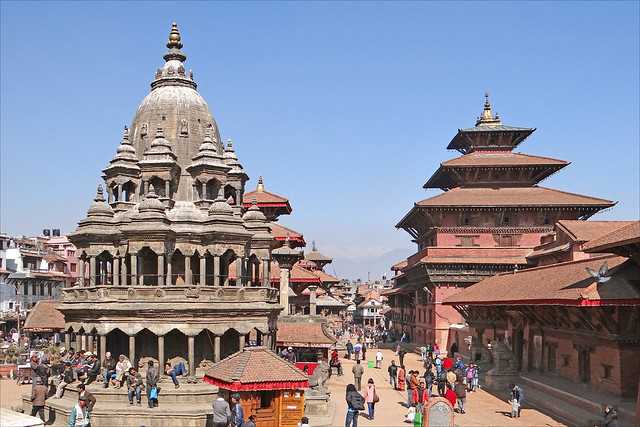
Another Durbar squares located in the Kathmandu Valley is the Patan Durbar Square, which is claimed to be one of the most famous tourist attractions in Nepal. Even though the history of the inception of this Square is unknown, however, one common belief is that the Malla rulers made most of the significant changes.
Architecture
With around 130 courtyards known as “bahals” and 55 major temples, the square is divided into two parts. The ancient royal palaces are housed within the inner complex of the Durbar square. The numerous pagoda-shaped temples in the outer complex with usually more than two tiers of the roof and intricate artwork, bespeak of the exceptional talents of the Newars.
Highlights
At the centre of the square lies an exquisite display of exceptional architecture, claimed to be one of the best works of the Newars, has a unique Hanuman idol guarding the palace. With idols of numerous Hindu mythological gods and goddesses like Lord Shiva, Goddess Parvati and Lord Krishna, this is one of the most beautiful works of the Newars.
UNESCO Recognised
The Patan Dubar Square was declared as a World Heritage Site by UNESCO in 1979.
Style of Architecture: Pagoda Style
Entry Fees
Foreign National: NPR 1000
SAARC Nationals: NPR 250
Location: Patan
4. Bhaktapur Durbar Square
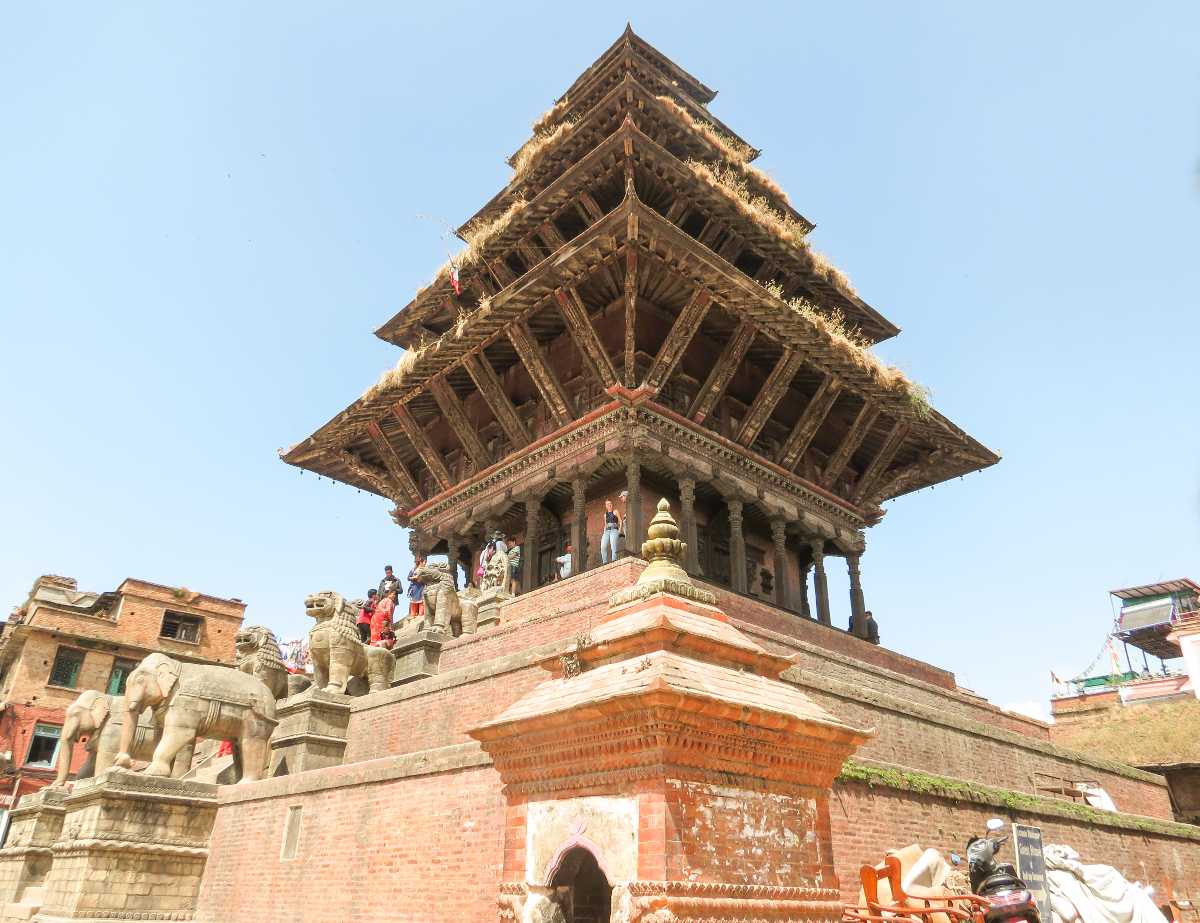
Bhaktapur Durbar Square, one of the three durbars in the Kathmandu valley, portrays a perfect picture of the rich cultural background of Nepal, especially the Newari community. One of the most beautiful heritage sites in Nepal, it was built by King Bhupatindra Malla, during the Malla reign, in the 17th century.
Architecture
It consists of four squares, namely, the Durbar Square, Taumadhi Square, Dattatreya Square and the Pottery Square along with numerous temples having multiples roofs. The Durbar complex also houses many sculptures of ancient rulers and live sized animals of religious importance, on stone plinths.
Highlights
The fifty-five window Palace, one of the main attractions of this Square, has a Golden gate at the entrance and intricate carvings of religious verses engraved, adorn the walls of the square.
UNESCO Recognised
Some of the prominent temples in this UNESCO World Heritage Site are the Vatsala temple, Bhairavnath temple, Nyatapola temple, the mini Pashupati temple etc.
Style of Architecture: A combination of Pagoda and Shikhara style.
Entry Fee
Nepalese Citizens: No entry fee
Foreign Nationals: NPR 1500
SAARC Nationals: NPR 500
Location:Bhaktapur
5. Kasthamandap Temple
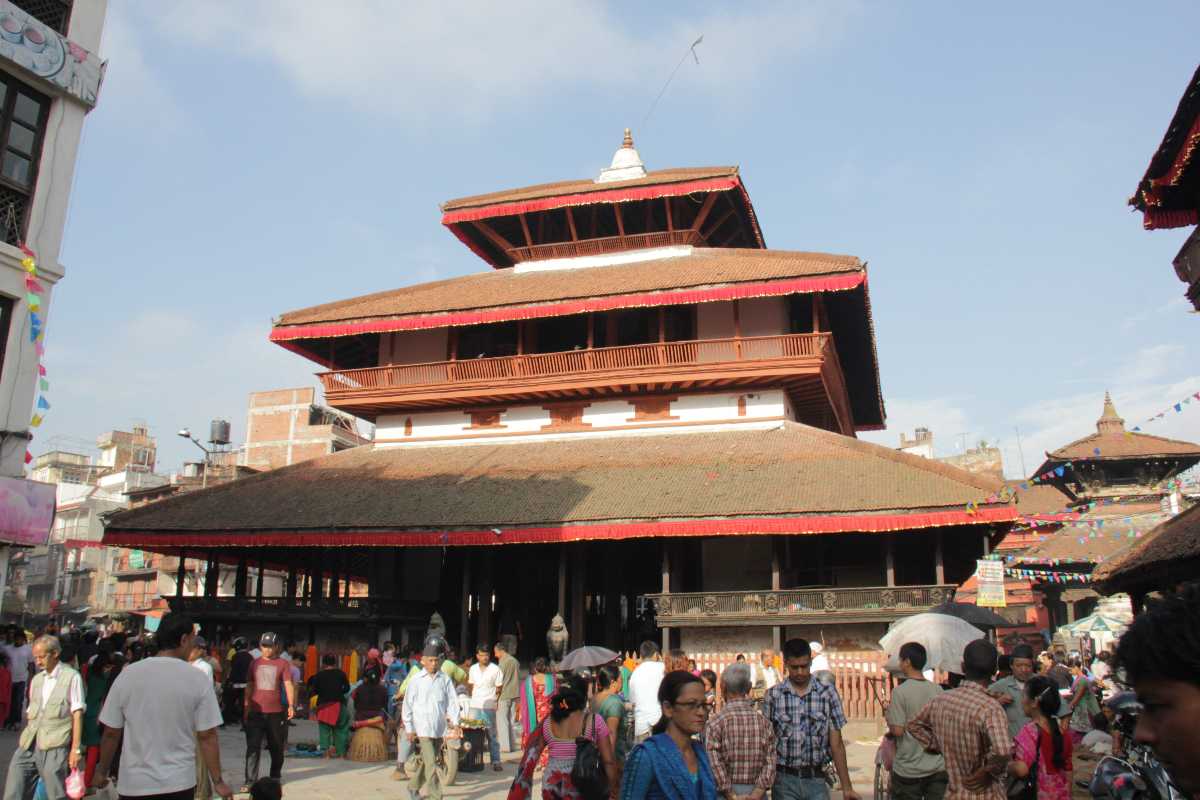
Kasthamandap temple is a three-tier temple located in the Hanuman Dhoka Durbar Square, which dates back to the age of the Malla reign. It translates to ‘wood-pavilion’ and is believed to have been built from a single tree. Initially, it served as a ‘mandapa’, or a podium for sacred ceremonies, however, it was later made into a temple dedicated to Saint Gorakhnath. According to ancient manuscripts, saint Gorakhnath is said to have joined a chariot procession of Machhindranath disguised as a human, when he was spotted by a ‘tantric’, who cursed him for a lifetime of imprisonment. However, later, it is believed that a deal was made between the two according to which, Gorakhnath grew a sal tree, which was used by the tantric to build the temple.
Architecture
Also known as ‘Maru Satal’, this temple, dedicated to Saint Gorakhnath, has a very peculiar nature. His footprints have always represented the idol of this temple.
Highlights
This three-tier Pagoda temple, however, lacks a pinnacle, which is an integral part of the pagoda style.
Style of Architecture: Pagoda Style
No entry fee
Location-Kathmandu
6. Changu Narayan Temple
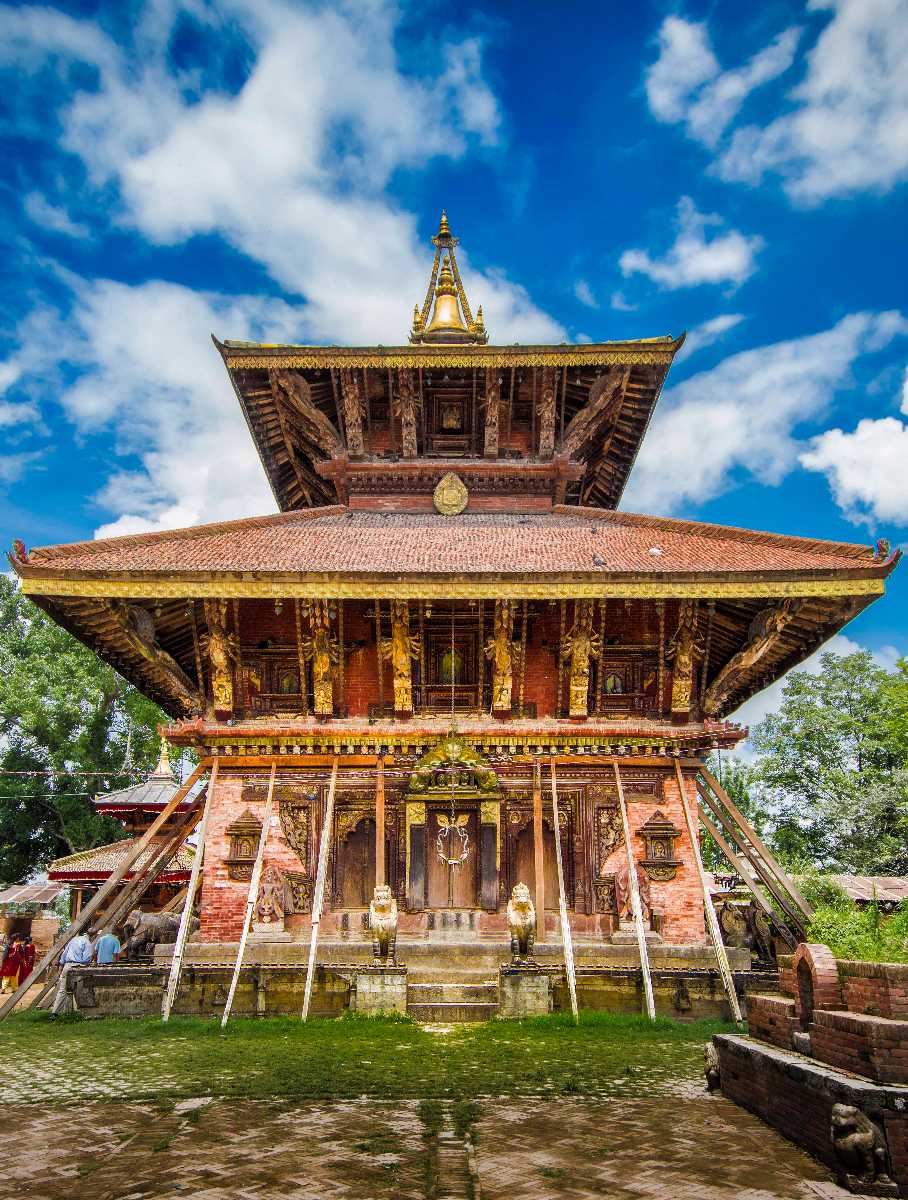
The journey to the temple of Changu Narayan who climbs through several steps, through a small picturesque Nepalese village known as Narayan. The origins of this Hindu temple dates back to the 4th century AD, according to the inscription on a garuda column in the temple. This temple was dedicated to Lord Vishnu, who appears as ‘Narayana’ or the creator of a new age.
Architecture
The entire temple complex is full of colourful sculptures, beautifully carved out of wood. Considered to be one of Nepal’s oldest temples, the dual roofed temple, sits over a high plinth and has fours ‘dwars’ or entrances, which are guarded by life-sized sculptures of lions and garudas. Various incarnations of Lord Vishnu are engraved on the struts supporting the roofs of the temple.
Highlights
Most of the stone pillars in the temple have shlokas or verses, inscribed on them, which are of great importance to the Hindu religion.
UNESCO Recognised
The Changu Narayan Temple is a UNESCO World Heritage Site; however, very few tourists visit this place, which helps to maintain the tranquillity of the Narayana Village.
Style of Architecture: Pagoda Style
Entry fee
Nepalese Citizens: No entry fee
Foreign Nationals: NPR 300
SAARC Nationals: NPR 100
Location:Changunarayan
7. Boudhanath Stupa
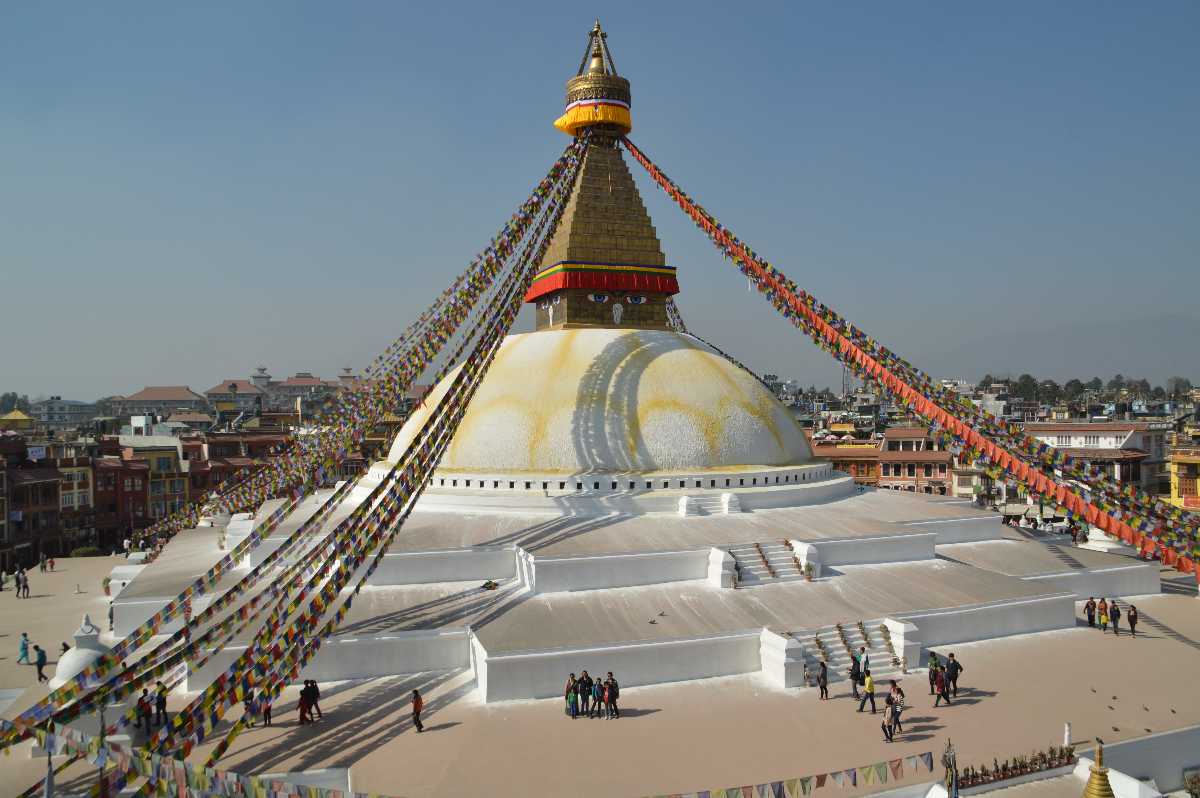
One of the most auspicious Buddhist shrines in Nepal, this Stupa is more than 1500 years old and attracts followers of all religions, especially Buddhism, on a large scale. Legend has it that it was built by Songtsen Gampo, a Tibetan King after he unintentionally killed his father.
Architecture
Standing at the height of around 118 feet, it is one of the seven UNESCO World Heritage Sites in Nepal. It has a massive white hemispherical dome with a golden pinnacle and eyes painted on all sides of it. Every part of this architectural marvel has a special significance.
Architectural Symbols
The pinnacle of the stupa represents Mt.Sumera, the centre of the spiritual universes, believed to be the home of gods. The gilded canopy is representative of air, and the thirteen steps of the stupa represent the path to enlightenment or ‘Bodhi’. A pair of eyes, painted on all sides of the central tower, represents the all-knowing nature of Lord Buddha while the nose, painted just below the eyes symbolises unity and the only way to reach ‘bodhi’ or spiritual enlightenment. The hemispherical dome of the stupa represents the universe. The two circular plinths supporting the hemispherical dome is symbolic of water.
Style of Architecture: Stupa Style
Entry fee
Nepalese citizens: No entry fee
Foreign Nationals: NPR 400
SAARC Nationals: NPR 100
Location: Kathmandu
8. Namobuddha Stupa
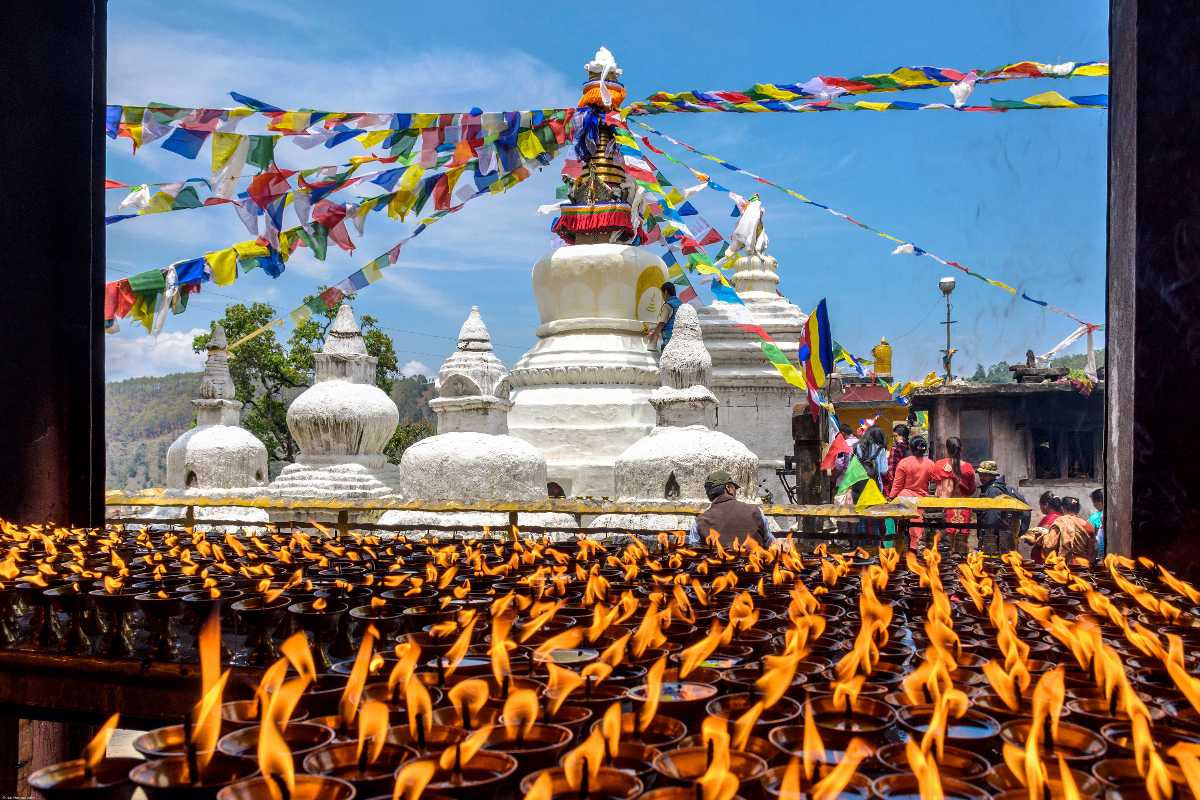
It is one of the most sacred pilgrimage sites for Buddhists, across the world. Legend has it that it was the place where Lord Buddha, in his previous birth as a prince, sacrificed his body to a starving tigress and her cubs and hence, the site is sometimes also referred to as “Takmo Lu Jin”, which means ‘Tigress Body Generosity” in Tibetan. Pilgrims believe that this stupa was built on top of the remains of Lord Buddha, to celebrate his great sacrifice.
Architecture and Symbols
Namobuddha Stupa consists of a pinnacle at the top, a hemispherical dome, not as large as the other stupas and five other smaller stupas, along with the main one, depicting the five elements of Buddhism namely air, water, fire, earth and space.
Style of Architecture: Stupa Style
No entry fee
Location-Kathmandu
9. Swayambhunath Stupa
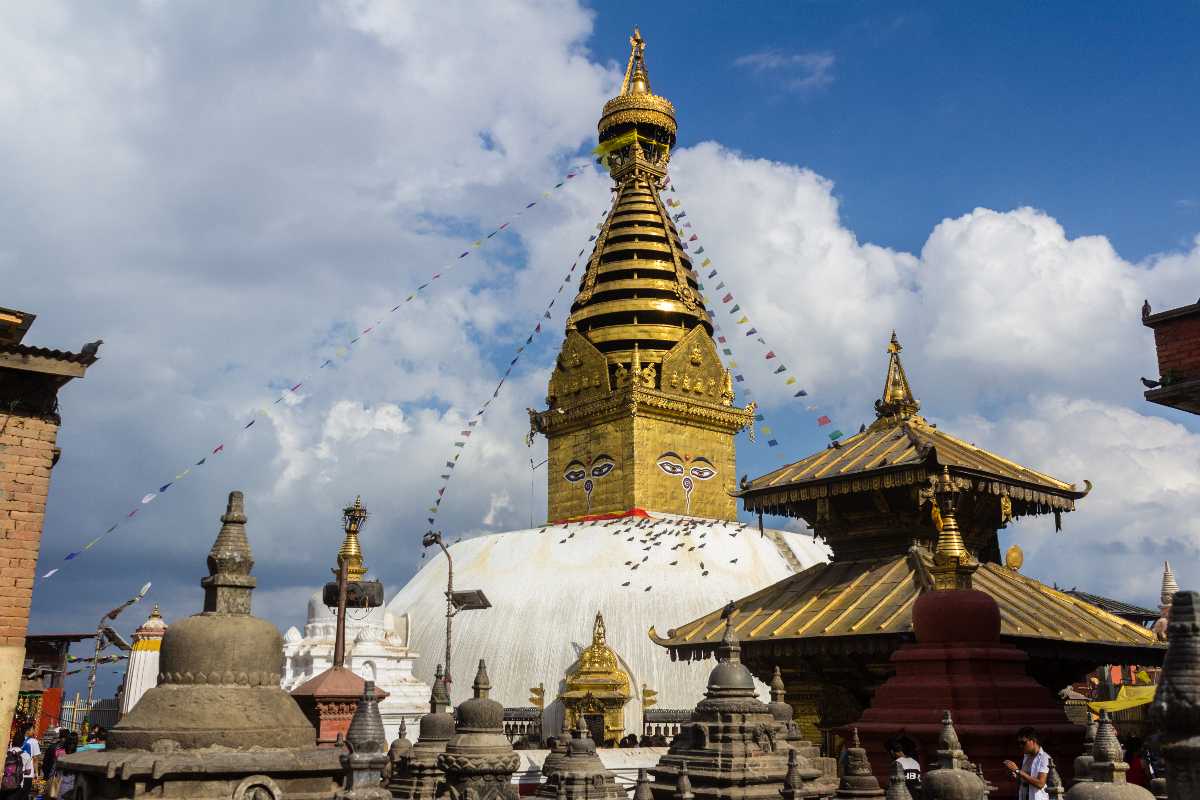
Considered to be the most powerful shrine for Buddhist Pilgrimage, this stupa is one of Nepal’s more impressive architectural marvels. Swayambhunath means ‘self-made’. It is situated in the Kathmandu valley, and dedicated pilgrims need to climb 365 stairs to get to the top of the stupa. According to a well-known legend, the valley was once a gigantic lake, which grew a lotus, but later, the water dried and the lotus became the sacred Swayambhunath stupa.
Architecture and Symbols
Popularly known as ‘Monkey Temple’, the Swayambhunath Stupa has a white hemispherical dome, which symbolises the earth and the 13 tiers of the spire represent the different stages one must pass through to achieve spiritual enlightenment or Nirvana. It has three eyes painted on each side, where the pair of eyes or the “all-seeing eyes” depict the omnipresence of Lord Buddha, whereas the third eye symbolises wisdom. The curly question mark shaped nose is symbolic of unity.
Style of Architecture: Stupa Style
Entry fee
Nepalese citizens: No entry fee
Foreign Nationals: NPR 200
SAARC Nationals:NPR 50
Location: Kathmandu
10. Krishna Mandir
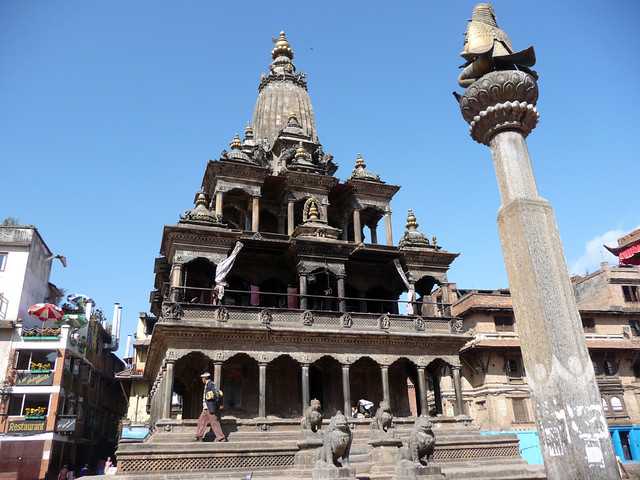
Built by King Siddhinarsingha Malla of the Malla regime, this temple is perhaps one of the best examples of shikhara style architecture of Nepal. Legend has it that this temple was built, as an outcome of a dream that the king had, where he visualised Lord Krishna, standing in front of his palace. He then decided to build a Krishna temple at that very spot. Every year in August and September, the temple holds Krishna Jayanta to celebrate the birthday of Lord Krishna.
Architecture and Symbols
The structure of this Krishna Mandir has 21 perfectly shaped pinnacles, with exquisite artwork, depicting the exceptional finesse and quality of work, by the Nepalese craftsmen of the ancient times. Beneath the spires, lie three floors, each of which is said to house three different deities, namely Lord Shiva, Lord Krishna and Lord Lokeshwar.
Style of Architecture: Shikhara Style
No entry fee
Location-Patan Durbar Square, Kathmandu
11. Mahabouddha Temple
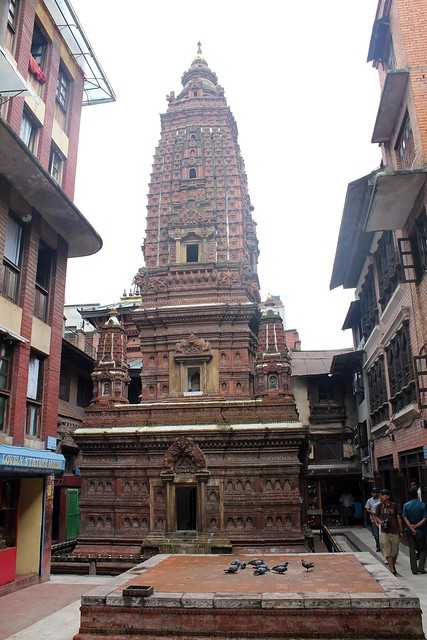
Mahabouddha temple gets its name from the thousand and eight terracotta tiles that cover the entire temple structure. It is believed to have been constructed in the 16th century, by a devotee named Abhaya Raj Shakya from Patan, who was inspired after visiting the Mahabodhi Temple in India, where Lord Buddha is said to have attained enlightenment. He learnt the art of making coins and later when he was given permission to build a mint, he started constructing this temple. Due to his sudden demise, his son completed building this marvellous structure. Even today, this ancient shikhara-style temple stands tall in a small courtyard amidst the hurly-burly of the local markets.
Architecture
Built with a thousand and eight terracotta tiles, the Mahabouddha Temple is truly an architectural marvel. Every inch of this temple is etched with an image of Lord Buddha into it. Even today, this ancient shikhara-style temple stands tall in a small courtyard amidst the hurly-burly of the local markets.
Style of Architecture: Shikhara StyleNepal is not just a country blessed with breathtaking beauty in abundance, but it is also a country blessed with gifted artisans, who have made the country even more beautiful with their artistic talents. With a perfect amalgamation of both Hindu and Buddhist cultures, the architecture of Nepal is worth giving this nation a visit.
Entry fee
Foreign Nationals: NPR 80
SAARC Nationals: NPR 30
Location: Patan Durbar Square, Kathmandu
